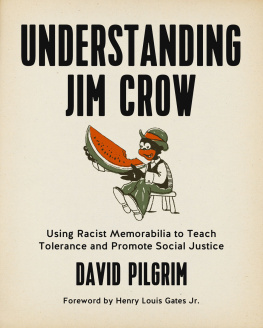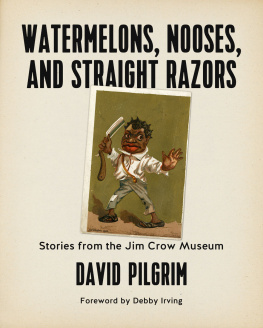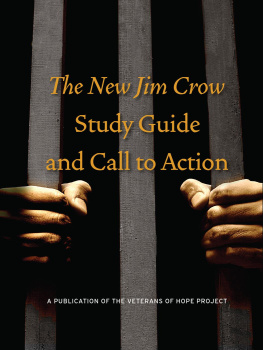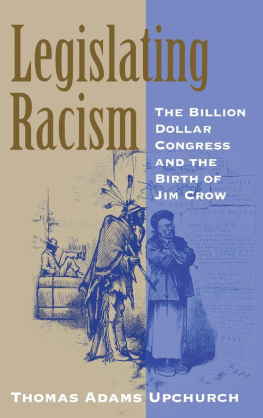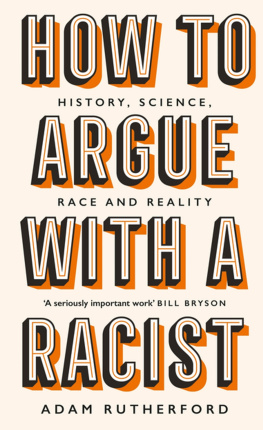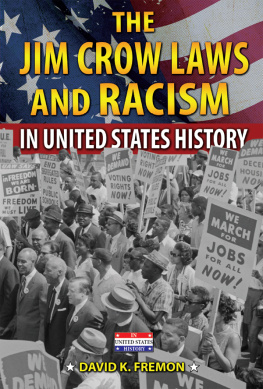Praise for Understanding Jim Crow and the Jim Crow Museum
One of the most important contributions to the study of American history that I have ever experienced.
Henry Louis Gates Jr., director of the W.E.B. Du Bois Institute for African American Research
For decades the author has been on a Pilgrimage to bring out from our dank closets the racial skeletons of our past. His is a crucial mission, because he forces us to realize that race relations grew worse in the first several decades of the twentieth centurysomething many Americans never knew or now want to suppress. This book allows us to see, even feel the racism of just a generation or two agoand Pilgrim shows that elements of it continue, even today. See it! Read it! Feel it! Then help us all transcend it!
James W. Loewen, author of Lies My Teacher Told Me and coeditor of The Confederate and Neo-Confederate Reader
This was a horrific time in our history, but it needs to be taught and seen and heard. This is very well done, very well done.
Malaak Shabazz, daughter of Malcolm X and Betty Shabazz
The museums contents are only a small part of the damaging effects of the Jim Crow laws that were found all across America, including bright and sunny California. This history is not only an important part of understanding where America was but, in an age of states making it harder and harder for citizens to vote, it is relevant to note that we have been here before.
Henry Rollins, host of the History Channels 10 Things You Dont Know About
The museum has been one of my treasured go-to resources for teaching people about the deep-seated roots of the racism that persists in our collective subconscious. Only by facing our history and its hold on our psyche can we construct a better culture. This work is invaluable.
damali ayo, author of How to Rent a Negro and Obamistan! Land without Racism
David Pilgrim makes a vital contribution to help us understand the grotesque depths of the psychological and cultural war of anti-black racism throughout the Jim Crow era. In our quest to build powerful multiracial grassroots movements for collective liberation, Pilgrims book is a tool to help decolonize our minds, attack anti-black racism in all of its forms, and create a multiracial democracy with economic justice for all.
Chris Crass, author of Towards Collective Liberation: Anti-Racist Organizing, Feminist Praxis, and Movement Building Strategy

Understanding Jim Crow: Using Racist Memorabilia to Teach Tolerance and Promote Social Justice
David Pilgrim
Copyright 2015 Ferris State University and PM Press
All rights reserved. No part of this book may be transmitted by any means without permission in writing from the publisher.
ISBN: 9781629631141
Library of Congress Control Number: 2015930901
Cover by John Yates/Stealworks
Interior design by briandesign
10 9 8 7 6 5 4 3 2 1
PM Press
PO Box 23912
Oakland, CA 94623
www.pmpress.org
This edition first published in Canada in 2015 by Between the Lines
401 Richmond Street West, Studio 277, Toronto, Ontario, M5V 3A8, Canada
18007187201
www.btlbooks.com
All rights reserved. No part of this publication may be photocopied, reproduced, stored in a retrieval system, or transmitted in any form or by any means, electronic, mechanical, recording, or otherwise, without the written permission of the publisher or (for photocopying in Canada only) Access Copyright www.accesscopyright.ca.
Canadian cataloguing information is available from Library and Archives Canada.
ISBN 9781771132503 Between the Lines paperback
ISBN 9781771132510 Between the Lines epub
ISBN 9781771132527 Between the Lines pdf
Printed in the USA by the Employee Owners of Thomson-Shore in Dexter, Michigan.
www.thomsonshore.com
Contents

Foreword
There was nothing understated about Jim Crow during that long, blistering century between the end of Reconstruction and the seminal legal victories of the American civil rights movement. Racist imagery essentializing blacks as inferior beings was as exaggerated as it was ubiquitous. The onslaught was constant.
Never mind that African Americans had only recently pulled off a miracle of human history, of enduring centuries of bondage to claim their freedom after a bloody four-year Civil War, many of them having served in the Union army and navy. After a brief decade of promise, there were, in Jim Crows America, only lazy stereotypes to accompany the reassertion of white supremacy over black people depicted as guileless, shiftless, empty-headed, terrified, and connivingclichs of clichs. Jim Crows propaganda, stark and shocking, was designed to convince the American publicincluding blacks themselvesthat they were all those things. It was exhausting: the pervasiveness of antiblack humor in newspapers, on store shelves, at the cinema, and along kitschy restaurant walls; Jim Crows obsession withand oversexualizing ofblack bodies; and the frightening, gleaming delight those most committed to maintaining the color line in America took in policing the boundaries with the noose and gun and then posing for pictures with their victims mutilated remains as if at a family picnic or barbecue.
No, there was nothing understated about Jim Crow.
Under-standing Jim Crow, however, is a different matter, with one question leading to countless others. How and why did de jure and de facto segregation evolve out of the unification of the country after the Civil War, and why did it last for so long? How could anyone look at a real black person, of any period or station, and not see the shameful discrepancies between her or him and how black people, en masse, were portrayed in Jim Crows America under the slanderous archetypes of picaninny, Tom, Sambo, coon, Jezebel, tragic mulatto, and mammy? Why those stereotypes and not others? Who masterminded them, what fantasies and fears were they projecting, and what were they trying to get others to buy? What were the real stakes involved? And when and how did African Americans take control of their own narrative, and the imagery needed to tell it, from silent film reels to I Am a Man signs, and fight back?
This is where David Pilgrim, the author of this book and founder of the Jim Crow Museum at Ferris State University in Big Rapids, Michigan, comes in. Reared in the Deep South during the tumultuous waning days of segregationwhen a learned black professor at a Christian college still had to wear a chauffeurs hat to avoid unwanted attention driving his own car, bought with his own teachers salaryPilgrim channeled his anger in a way few would have thought of or dared. He began cornering the market on Jim Crow memorabilia, collecting with feverish intensity the odds and ends of the very system that had underwritten the racism he saw and felt everywhere around him.
Nothing was too trivial or disturbing for Pilgrims net. Whereas most black kids coming of age in the 1960s and 1970s would have worked hard to block out the viciousness and cruelty depicted in vintage lynching postcards found in the shuffle, and turn off to the stock characters exaggeratedly drawn on brand-name cereal and soap boxes, Pilgrim opened his wallet, determined to buy up as much racist memorabilia as he could locate in order to confrontand, in doing so, masterthe propaganda that accompanied the degradation of a people as they were emerging from centuries of slavery after the Civil War.

